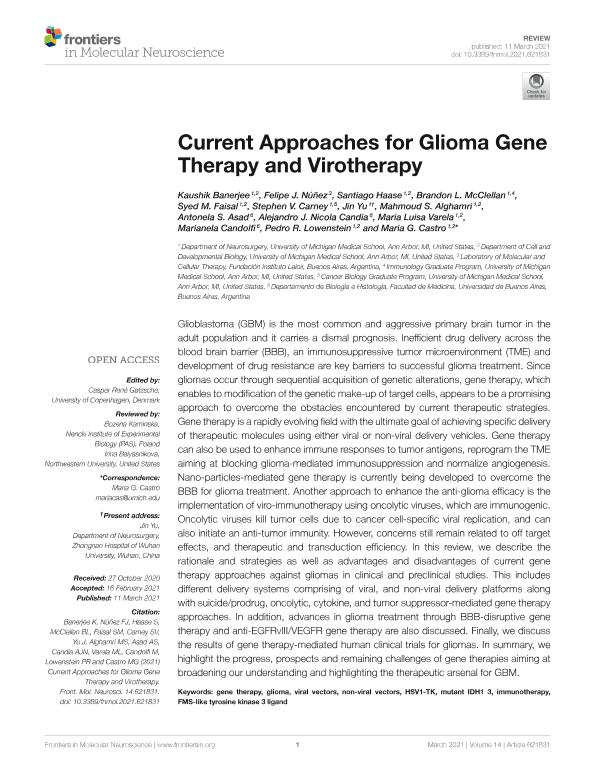Mostrar el registro sencillo del ítem
dc.contributor.author
Banerjee, Kaushik
dc.contributor.author
Núñez Aguilera, Felipe Javier

dc.contributor.author
Haase, Santiago
dc.contributor.author
McClellan, Brandon L.
dc.contributor.author
Faisal, Syed M.
dc.contributor.author
Carney, Stephen V.
dc.contributor.author
Yu, Jin
dc.contributor.author
Alghamri, Mahmoud S.
dc.contributor.author
Asad, Antonela Sofía

dc.contributor.author
Nicola Candia, Alejandro Javier

dc.contributor.author
Varela, Maria Luisa
dc.contributor.author
Candolfi, Marianela

dc.contributor.author
Lowenstein, Pedro R.
dc.contributor.author
Castro, Maria G.
dc.date.available
2023-10-06T10:51:13Z
dc.date.issued
2021-03
dc.identifier.citation
Banerjee, Kaushik; Núñez Aguilera, Felipe Javier; Haase, Santiago; McClellan, Brandon L.; Faisal, Syed M.; et al.; Current Approaches for Glioma Gene Therapy and Virotherapy; Frontiers Media; Frontiers in Molecular Neuroscience; 14; 3-2021; 1-30
dc.identifier.issn
1662-5099
dc.identifier.uri
http://hdl.handle.net/11336/214289
dc.description.abstract
Glioblastoma (GBM) is the most common and aggressive primary brain tumor in the adult population and it carries a dismal prognosis. Inefficient drug delivery across the blood brain barrier (BBB), an immunosuppressive tumor microenvironment (TME) and development of drug resistance are key barriers to successful glioma treatment. Since gliomas occur through sequential acquisition of genetic alterations, gene therapy, which enables to modification of the genetic make-up of target cells, appears to be a promising approach to overcome the obstacles encountered by current therapeutic strategies. Gene therapy is a rapidly evolving field with the ultimate goal of achieving specific delivery of therapeutic molecules using either viral or non-viral delivery vehicles. Gene therapy can also be used to enhance immune responses to tumor antigens, reprogram the TME aiming at blocking glioma-mediated immunosuppression and normalize angiogenesis. Nano-particles-mediated gene therapy is currently being developed to overcome the BBB for glioma treatment. Another approach to enhance the anti-glioma efficacy is the implementation of viro-immunotherapy using oncolytic viruses, which are immunogenic. Oncolytic viruses kill tumor cells due to cancer cell-specific viral replication, and can also initiate an anti-tumor immunity. However, concerns still remain related to off target effects, and therapeutic and transduction efficiency. In this review, we describe the rationale and strategies as well as advantages and disadvantages of current gene therapy approaches against gliomas in clinical and preclinical studies. This includes different delivery systems comprising of viral, and non-viral delivery platforms along with suicide/prodrug, oncolytic, cytokine, and tumor suppressor-mediated gene therapy approaches. In addition, advances in glioma treatment through BBB-disruptive gene therapy and anti-EGFRvIII/VEGFR gene therapy are also discussed. Finally, we discuss the results of gene therapy-mediated human clinical trials for gliomas. In summary, we highlight the progress, prospects and remaining challenges of gene therapies aiming at broadening our understanding and highlighting the therapeutic arsenal for GBM.
dc.format
application/pdf
dc.language.iso
eng
dc.publisher
Frontiers Media

dc.rights
info:eu-repo/semantics/openAccess
dc.rights.uri
https://creativecommons.org/licenses/by-nc-sa/2.5/ar/
dc.subject
FMS-LIKE TYROSINE KINASE 3 LIGAND
dc.subject
GENE THERAPY
dc.subject
GLIOMA
dc.subject
HSV1-TK
dc.subject
IMMUNOTHERAPY
dc.subject
MUTANT IDH1 3
dc.subject
NON-VIRAL VECTORS
dc.subject
VIRAL VECTORS
dc.subject.classification
Otras Ciencias de la Salud

dc.subject.classification
Ciencias de la Salud

dc.subject.classification
CIENCIAS MÉDICAS Y DE LA SALUD

dc.title
Current Approaches for Glioma Gene Therapy and Virotherapy
dc.type
info:eu-repo/semantics/article
dc.type
info:ar-repo/semantics/artículo
dc.type
info:eu-repo/semantics/publishedVersion
dc.date.updated
2023-10-05T14:56:22Z
dc.journal.volume
14
dc.journal.pagination
1-30
dc.journal.pais
Suiza

dc.journal.ciudad
laussane
dc.description.fil
Fil: Banerjee, Kaushik. University of Michigan; Estados Unidos
dc.description.fil
Fil: Núñez Aguilera, Felipe Javier. Fundación Instituto Leloir; Argentina
dc.description.fil
Fil: Haase, Santiago. University of Michigan; Estados Unidos
dc.description.fil
Fil: McClellan, Brandon L.. University of Michigan; Estados Unidos
dc.description.fil
Fil: Faisal, Syed M.. University of Michigan; Estados Unidos
dc.description.fil
Fil: Carney, Stephen V.. University of Michigan; Estados Unidos
dc.description.fil
Fil: Yu, Jin. University of Michigan; Estados Unidos
dc.description.fil
Fil: Alghamri, Mahmoud S.. University of Michigan; Estados Unidos
dc.description.fil
Fil: Asad, Antonela Sofía. Consejo Nacional de Investigaciones Científicas y Técnicas. Oficina de Coordinación Administrativa Houssay. Instituto de Investigaciones Biomédicas. Universidad de Buenos Aires. Facultad de Medicina. Instituto de Investigaciones Biomédicas; Argentina
dc.description.fil
Fil: Nicola Candia, Alejandro Javier. Consejo Nacional de Investigaciones Científicas y Técnicas. Oficina de Coordinación Administrativa Houssay. Instituto de Investigaciones Biomédicas. Universidad de Buenos Aires. Facultad de Medicina. Instituto de Investigaciones Biomédicas; Argentina
dc.description.fil
Fil: Varela, Maria Luisa. University of Michigan; Estados Unidos
dc.description.fil
Fil: Candolfi, Marianela. Consejo Nacional de Investigaciones Científicas y Técnicas. Oficina de Coordinación Administrativa Houssay. Instituto de Investigaciones Biomédicas. Universidad de Buenos Aires. Facultad de Medicina. Instituto de Investigaciones Biomédicas; Argentina
dc.description.fil
Fil: Lowenstein, Pedro R.. University of Michigan; Estados Unidos
dc.description.fil
Fil: Castro, Maria G.. University of Michigan; Estados Unidos
dc.journal.title
Frontiers in Molecular Neuroscience
dc.relation.alternativeid
info:eu-repo/semantics/altIdentifier/url/https://www.frontiersin.org/articles/10.3389/fnmol.2021.621831/full
dc.relation.alternativeid
info:eu-repo/semantics/altIdentifier/doi/http://dx.doi.org/10.3389/fnmol.2021.621831
Archivos asociados
